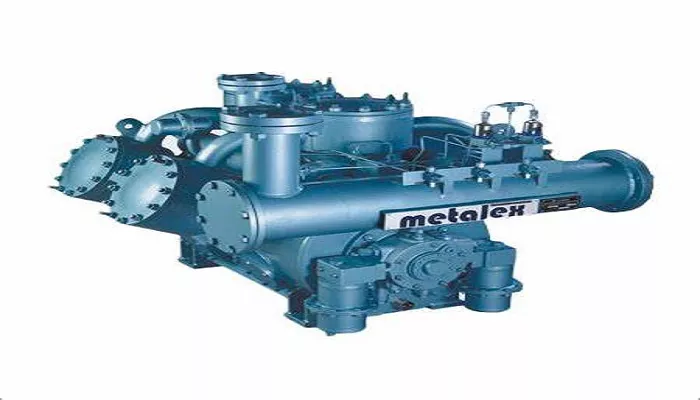Ammonia (NH₃) compressors are critical components in industrial refrigeration systems, widely used in food processing, cold storage, and chemical industries. These compressors are designed to handle ammonia’s unique thermodynamic properties, ensuring efficient and reliable cooling. This article provides a detailed, professional explanation of how an ammonia compressor works, covering its types, working principles, key components, and operational considerations.
Types of Ammonia Compressors
Reciprocating Compressors
- Use pistons driven by a crankshaft to compress ammonia vapor.
- Suitable for small to medium-capacity applications.
- High efficiency but require regular maintenance due to moving parts.
Screw Compressors (Rotary)
- Use two interlocking helical rotors to compress gas.
- Ideal for medium to large-capacity systems.
- Offer continuous operation with minimal vibration.
Centrifugal Compressors
- Utilize high-speed impellers to accelerate and compress ammonia vapor.
- Best for very large refrigeration systems.
- High flow rates but less efficient at partial loads.
Each type has advantages depending on system size, efficiency needs, and maintenance requirements.
Working Principle of an Ammonia Compressor
Suction Phase
- Low-pressure ammonia vapor (from the evaporator) enters the compressor.
- The suction valve opens, allowing gas into the compression chamber.
Compression Phase
- The compressor reduces the gas volume, increasing pressure and temperature.
- In reciprocating compressors, pistons move upward; in screw compressors, rotors mesh to squeeze the gas.
Discharge Phase
- High-pressure ammonia vapor exits through the discharge valve.
- The gas flows to the condenser, where it releases heat and liquefies.
Cooling and Lubrication
- Oil injection (in screw compressors) or cooling jackets (in reciprocating models) prevent overheating.
- Proper lubrication ensures smooth operation and reduces wear.
Key Components of an Ammonia Compressor
Compressor Body
- Houses pistons, rotors, or impellers depending on type.
- Made of cast iron or steel to withstand high pressures.
Motor and Drive System
- Electric motors (or engines) power the compressor.
- Belt-driven or direct-coupled for energy transfer.
Valves (Suction & Discharge)
- Check valves ensure one-way flow.
- Prevent backflow, improving efficiency.
Oil Separator
- Removes lubricating oil from compressed ammonia.
- Recirculates oil back to the compressor.
Cooling System
- Water or air-cooled to manage heat buildup.
- Critical for preventing thermal stress.
Control Systems
- Pressure sensors, temperature monitors, and safety cutoffs.
- Ensure stable operation and prevent damage.
Thermodynamics of Ammonia Compression
Boyle’s Law (Pressure-Volume Relationship)
- As volume decreases, pressure increases (P₁V₁ = P₂V₂).
Charles’s Law (Temperature-Volume Relationship)
- Compressing gas raises its temperature (V₁/T₁ = V₂/T₂).
Isentropic Efficiency
- Measures how effectively the compressor converts energy into pressure.
- Real-world compressors experience losses due to friction and heat.
Operational Considerations
Pressure Ratios
- The ratio of discharge to suction pressure affects performance.
- Too high a ratio can cause overheating.
Lubrication Management
- Oil must be compatible with ammonia (typically synthetic or mineral oils).
- Oil changes and filtration prevent contamination.
Vapor Quality
- Liquid ammonia entering the compressor (floodback) can cause damage.
- Suction line accumulators prevent this issue.
Maintenance Practices
- Regular inspection of valves, seals, and bearings.
- Monitoring vibration and noise for early fault detection.
Safety Measures for Ammonia Compressors
Leak Detection
- Sensors alert operators to ammonia leaks.
- Proper ventilation reduces explosion risks.
Emergency Shutdown Systems
- Automatic cutoffs in case of excessive pressure or temperature.
Personal Protective Equipment (PPE)
- Workers must wear gloves, goggles, and respirators when handling ammonia.
Energy Efficiency and Performance Optimization
Variable Speed Drives (VSDs)
- Adjust motor speed based on cooling demand.
- Saves energy during partial-load conditions.
Heat Recovery Systems
- Waste heat from compression can be reused for heating processes.
Proper Sizing
- Oversized compressors cycle excessively, wasting energy.
- Undersized units struggle to meet cooling demands.
Common Issues and Troubleshooting
| Problem | Possible Cause | Solution |
|---|---|---|
| High discharge temperature | Insufficient cooling, dirty condenser | Clean condenser, check coolant flow |
| Oil carryover | Faulty oil separator | Replace or repair separator |
| Excessive vibration | Misalignment, worn bearings | Realign shafts, replace bearings |
| Low suction pressure | Refrigerant shortage, clogged filter | Recharge ammonia, clean filters |
Future Trends in Ammonia Compressor Technology
- Magnetic Bearings: Reduce friction, improving efficiency.
- Digital Twin Technology: Simulates compressor performance for predictive maintenance.
- Green Ammonia: Using renewable energy to produce ammonia for sustainable refrigeration.
Conclusion
Ammonia compressors are essential in industrial refrigeration, operating on thermodynamic principles to transfer heat efficiently. Understanding their types, components, and maintenance ensures reliable performance while adhering to safety standards. Advances in technology continue to enhance efficiency, making ammonia compressors a sustainable choice for large-scale cooling applications.

